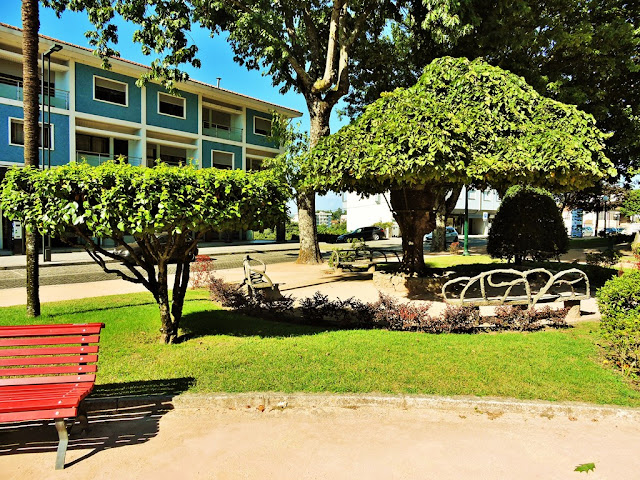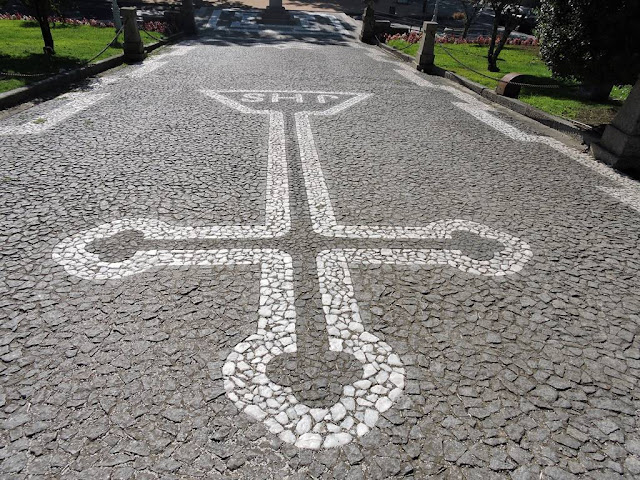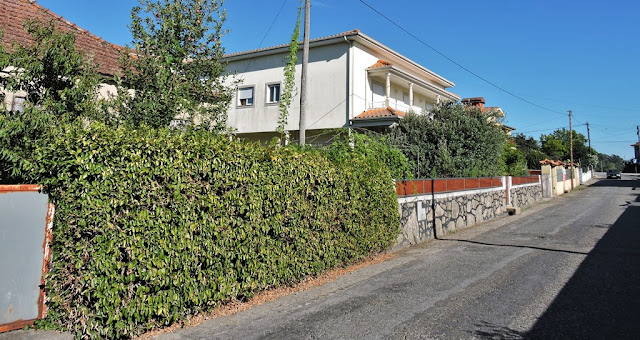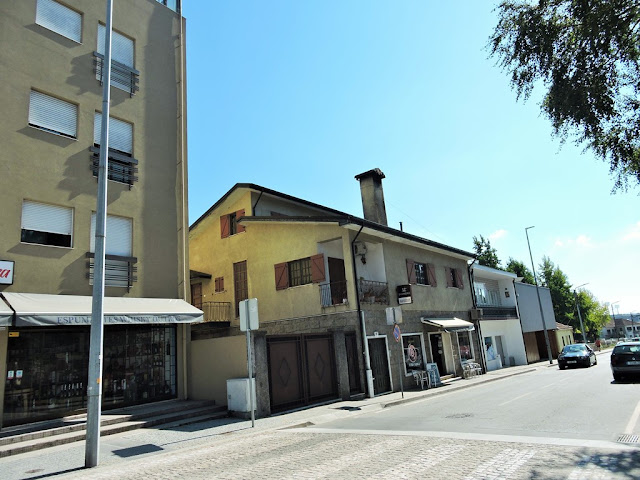PAÇOS DE FERREIRA
41° 16 ′N; 8° 24′ W
Paços de Ferreira is a Portuguese city located in the sub-region of Tâmega and Sousa, belonging to the North region and the district of Porto. It has an urban area of 8.31 km2, 13,418 inhabitants in 2021 and a population density of 1,614 inhabitants per km2.
It is the seat of the municipality of Paços de Ferreira, with a total area of 70.99 km2, 55,595 inhabitants in 2021 and a population density of 783 inhabitants per km2, subdivided into 12 parishes. The municipality is limited to the east by the municipality of Lousada, to the south by Paredes, to the southwest by Valongo and to the west and north by Santo Tirso.
It is known as the Capital of Furniture for being the most important furniture production center in Portugal, with around 5000 companies that make up the largest exhibition and furniture sales area in Europe, estimated at 2.5 million square meters.
At the beginning of the 20th century, a local teacher, Albino de Matos, invented a set of instruments that revolutionized the teaching of geometry in Portuguese primary schools. The factory that opened to produce these instruments grew quickly, having been the seed of the county's furniture industry, which, in the second half of the 20th century, with the economic development of the country, was reconverted, starting to produce domestic furniture.
In the following decades, the growth of this industry, which ended up becoming the most important in its sector in Portugal, made it possible to further increase the speed of population growth in the municipality. In the 1980s, the furniture fair "Capital do Móvel" began to take place, which made the municipality's industry famous and ended up giving it the "title" by which it is known today.
The municipality of Paços de Ferreira is made up of 12 parishes:
Carvalhosa (vila); Eiriz; Ferreira; Figueiró; Freamunde (cidade); Meixomil; Penamaior; Raimonda;
Seroa; Frazão e Arreigada; Paços de Ferreira; Sanfins, Lamoso e Codessos.
Despite its small area, the municipality of Paços de Ferreira has a very significant population, with 56,340 inhabitants in 2011. The population density is therefore quite high in this small municipality. The municipality's population is scattered, as is traditional in the Entre-Douro and Minho region. Thus, almost all parishes are homogeneous in terms of the number of inhabitants, with the map of parishes in the municipality being particularly balanced. Even so, the main population clusters are the cities of Paços de Ferreira and Freamunde, the towns of Frazão and Carvalhosa, and the towns of Ferreira and Seroa. Paços de Ferreira is one of the youngest municipalities in the country, and the population has been increasing significantly over the years, in all parishes. In fact, between 1991 and 2001, only the parish of Modelos did not see its population increase. Part of the population of the county, and also of the surrounding counties, see their jobs in the immense carpentry workshops that the municipality has, producing the same high quality furniture that is known throughout the country and internationally.
A significant prison population lives in the parish of Seroa, as the Vale do Sousa prison establishments and the Central Prison of the North are located there.
Climate
According to the Köppen-Geiger climate classification, Paços de Ferreira has a temperate climate with a rainy winter and a dry and slightly hot summer (Csb).
The average annual temperature is 13.0 °C (according to the 1955-1980 averages of the Paços de Ferreira agrarian station, now extinct) and rainfall is around 1700 to 1750 mm\year.
As it is located in a very peculiar area such as the plateau of Chã de Ferreira, and it is already about 30 km from the ocean, the weather conditions in Paços de Ferreira are often different from those found in coastal areas.
Thus, winters in Paços de Ferreira are relatively mild, with temperatures between 0 °C and 15 °C, with fairly frequent rainfall.
On average, nights with frost on the ground represent 59 days a year. The occurrence of snow is relatively rare, and snowfalls have decreased in frequency over the years. The last heavy snowfall in the municipality was recorded on January 9, 2009.
In winter, the small rivers Ferreira, Eiriz and Carvalhosa (these two affluents of the first) often overflow, making some bridges in the county impassable. This time of year is also characterized by high humidity.
Summers are usually hot and dry, with temperatures between 20 °C and 30 °C. Even so, the occurrence of extreme heat and drought phenomena is very rare.
Industry
The municipality of Paços de Ferreira exports around 400 million euros/year (source INE), standing out in the national panorama, thanks to the thriving furniture and textile industry.
With five thousand companies, within a radius of five kilometers, Paços de Ferreira has a furniture exhibition area of around 1 million square meters, 1.5 million square meters of production area, with an annual turnover of one billion euros, thus being the largest furniture exhibition and production center in Europe. Its furniture fair, held annually under the slogan "Capital do Móvel", is the most important in the sector in Portugal. The sector exports 80% of production, with an average value of 25 million euros per month.
The textile industry is the second strongest in the municipality, with 168 companies that produce 1.8% of national clothing.
Of note is the manufacture, in a factory in the parish of Carvalhosa, in the parish of Pacense, of swimsuits with LZR Racer technology, which allowed the breaking of dozens of world records in swimming, mainly during the 2008 Olympic Games, in which they were worn by Michael Phelps. Pacense confections also supply several world-renowned brands.
Tourism
Paços de Ferreira has several points of tourist interest that are worth a visit to anyone passing through this plateau. For those heading from Porto, the most recommended route for a walk is to take the EN 105 (towards Santo Tirso) to Água Longa, and then take the EN 207 to Paços de Ferreira. In this way, you will be able to appreciate the natural beauties of Serra da Agrela which, despite having been affected by some urban aberrations, namely the construction of some warehouses on its top, continues to be the lung of the municipality of Pacense.
At the end of the climb, you enter Seroa, the gateway par excellence to the "Capital of Furniture". This parish is one of the largest furniture showcases in the municipality, given the number of existing furniture industries and exhibitions. In Seroa, the Main Church stands out, a recent work, with bold architecture, which can be seen from the national road.
Eight kilometers ahead, we enter the town of Paços de Ferreira, which has already been described above. In terms of tourism, it is recommended to leave the city following the signs for the Monastery of Ferreira/Rota do Românico. This church is one of the most important monuments in the municipality, having decisively influenced its history. It is one of the 21 monuments that make up the Sousa Valley Romanesque Route. Romanesque style temple, dating from the 12th century, is one of the best examples of this architectural style in Entre-Douro and Minho, mixing three stylistic currents, originating in Porto, Zamora and Unhão. It served, for centuries, as a home to the monks of the Colegiada de São Pedro de Ferreira, which administered all the lands around it, the Couto de Ferreira. Still in the same parish, you can visit the Serra de São Tiago and its chapel, a very pleasant place, from where you can enjoy a panoramic view over the south of the Sousa Valley.
From Ferreira, it is recommended to go to Freamunde, a small town in the center of which several chapels can be seen, with emphasis on the Capela de São Francisco, and the old part of the urban nucleus, although, as in Paços de Ferreira, this is threatened by the real estate speculation. In Freamunde, you can take the road to Raimonda, and enjoy the view over the municipality of Lousada.
Here begins the visit to the northern part of the municipality, more rural and bucolic, but also with more points of interest. At the junction, you can follow the signs to the Dolmen of Lamoso, a megalithic funerary monument (mamoa) of great dimensions, probably dating from 3000 BC. It consists of a polygonal chamber, covered by a broken slab supported by nine pillars, all in blue granite, characteristic of the region. In the neighboring parish of Codessos is Alto da Sr.ª do Socorro, from where you can see the entire Vale do Ave, in particular the municipality of Vizela.
Next is the most important monument in the municipality of Paços de Ferreira. Citânia de Sanfins, located in the parishes of Eiriz and Sanfins de Ferreira, is the vestige of a fortified settlement, defended by three lines of walls and reinforced by an outer wall. The ruins, discovered in the 1950s and the target of a careful excavation, led, among others, by the archaeologist Martins Sarmento, show us today what a castrejo settlement from the 2nd century BC was. The reconstituted castrejo nucleus deserves special mention, which, in addition to the ruins, is a faithful reproduction of a set of castrejo dwellings, and the castrejo spa, where Pedra Formosa da Citânia is located. You can also see a replica of the original Statue of the Warrior, symbol of Citânia, whose original was incomprehensibly taken to Lisbon.
A visit to Citania is only complete with a visit to the Archaeological Museum, which is free of charge. The museum is housed in Solar dos Brandões, an old manor house. The Museum's permanent exhibition shows archaeological finds throughout the municipality, namely pottery pieces and gold, silver and bronze coins from various periods of pre-Christian history, from the Castro occupation to Romanization.
Heading towards Paços de Ferreira again, the Igreja Matriz de Carvalhosa, dedicated to São Tiago, deserves a visit. Its architecture is so rare that it is unique in Portugal.
It has such rarity due, among the others, to the fact that its interior is divided into two large naves that are exactly the same. Its very simple façade, however, should be highlighted, but where you can find a central niche with the beautiful gothic image of the patron saint, in limestone, which together with two images of Raimonda and Ferreira, constitute an important medieval imagery of the municipality. It should also be noted that, inside the same church, one can see an altar with the representation of the Tree of Jesse, an important work from the 18th century, with great iconographic significance, as it is one of three existing in Portugal. In the picturesque churchyard, you can see a sculpture by José Carlos Coelho, who lives in the village.
From Carvalhosa, take the EN 209 towards Porto. On this road, one can see, on the side of the road, located about 150 meters from Casa da Botica, the Joanina bridge, over the Carvalhosa river, which was built in the reign of King João V, in the aforementioned parish. It is built in stone and in Romanesque style.
In Meixomil, turn right at the roundabout towards the place where this visit to the county should end, its highest point, Monte do Pilar, located at an altitude of around 530 m, on the border between the municipalities of Paços from Ferreira and Santo Tirso. Here is installed the Radar Station No. 2 of the Portuguese Air Force (formerly the Detection and Conduct of Interception No. 12 Squadron). The park includes a picnic area, a bar and a small chapel. However, the biggest attraction in the Pilar area is the Cristo-Rei statue, built in 1961 to replace a previous one, destroyed by a violent storm, a year after it was built, in 1960. From the area surrounding the statue, it is possible to see , on sunny days, the entire Metropolitan Area of Porto, highlighting mainly points such as the cities of Porto, Vila Nova de Gaia (Monte daVirgin), Maia (Town Hall), Matosinhos (beaches and Petrogal refinery), Vila do Conde and Póvoa do Varzim, among others. Another pole of interest is the group of large cork oaks, which allow the enjoyment of shade in spring and summer for the traditional snacks that are made there. On the 15th of August, the pilgrimage to Nossa Senhora do Pilar is celebrated there, marked by the plentiful picnic lunches, band concerts and the majestic procession around the complex.
From here it is possible to quickly leave the county, either towards Santo Tirso, Famalicão and Braga via the EN 319, or towards Porto, Trás-os-Montes or south via the A42, from the Seroa interchange.
💓💓💓💓💓
Cête;
Maia;
PORTO - WHERE THE RIVER KISSES THE SEA;PORTO - Sao Bento Train Staion + Public
Transport in Oporto Metropolitan Area;
PORTO - PORTO ESSENTIALS I;
PORTO - PORTO ESSENTIALS II;
PORTO - PORTO ESSENTIALS III;
PORTO - PORTO ESSENTIALS IV;
Póvoa do Varzim;
💓💓💓💓💓
Return to mainland Portugal &
the Azores and Madeira islands





















































































































